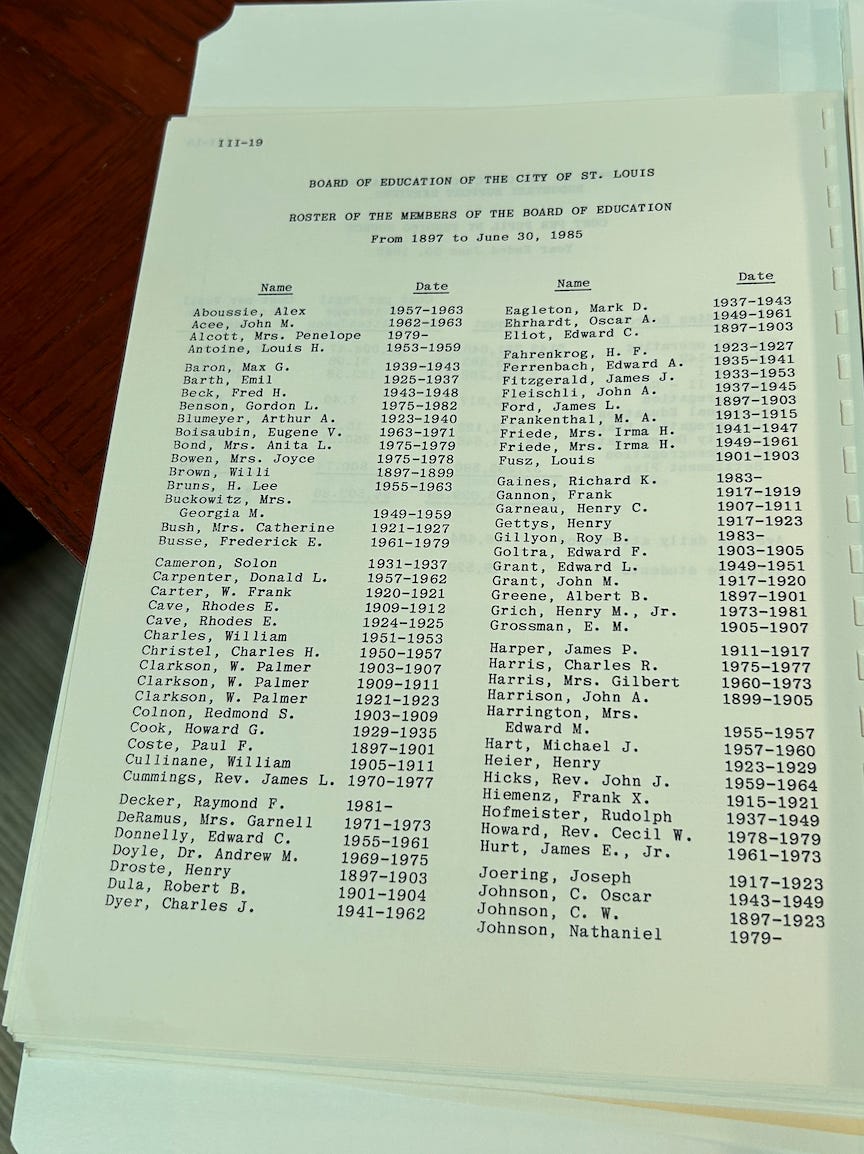One of the great things about being a parent is watching your child excel at things you can’t do yourself. Most recently, I’ve experienced this by cheering on my kid’s cross country and track teams. Even when I was young and fit, I didn't possess the skill or endurance or, let’s be honest, the desire to run. Somehow my child came into the world with more than enough of all three to be competitive. I’ve spent a lot of time lately observing how the runners prepare, how the coaches motivate to a win and comfort through a loss, and how SLPS families cheer on everyone to finish their race.
Maybe I’m just a nerd, too deep in the throes of my dissertation and too many years into policy-making to ever fully separate from my work, but at the last track meet of the season I saw a lesson in democracy. Multiple teams were disqualified from the relay after cascading mistakes in the baton handoff. The most obvious failure is to drop the baton, but here it was more nuanced. Instead, one runner turned out of their lane inhibiting another team’s handoff. That affected runner then obstructed the path of a third team. These few missteps, so slight as to only be noticed by the official and experienced fans, changed the outcome of the overall team standings.
For school boards, too, the handoff is an important part of the work. A cast of characters rotate on and off of the school board through election cycles even as the district’s goals, initiatives, and administration plan to stay the same. If the district and its students are to succeed, then the school board must make it a top priority to pass leadership from one hand to the next.
My dissertation focuses on the 1985 Long Range Plan developed by SLPS with cooperation from the City, so data collection has me sifting through boxes of old records at the Missouri History Museum Library and Research Center. Every now and then I come across a document that interrupts the monotony of budget allocations and personnel transaction reports to remind me that SLPS still stands as a democratic institution because of the contributions of regular people.
Buried in Box 75, Folder 15 of the A3030 Series for SLPS Records was a list of all members of the Board of Education of the City of St. Louis from 1897 to 1985. A list of nearly 100 years of individuals who volunteered their time, energy, and surely at least some of their sanity, to making SLPS better.
Without a doubt, they disagreed on how to define “better.” There were probably as many strategies for improvement as there were board members. Some of their ideas were certainly terrible. But in spite of all those differences, the work passed from one board member to the next.
We well know the district’s tumultuous era. Choices by administrators and board members, including the decision to bring in Alvarez & Marsal to restructure the district, contributed to a massive deficit, a revolving door of superintendents, and mass school closures. Consequently, an appointed three-member board governed the district for 12 years from 2007 to June 30, 2019. Now, only five years after the transition, we’re still learning our way back to democracy and into what it means for a city to feel ownership over its school system.
In a meeting packed with information, Dr. Scarlett’s June 11 presentation “The Future of SLPS: System Rebuild” stood out for its potential impact and influence both immediately and in the long-term. She outlined an ambitious four-year cycle that included the following stages:
Assess, 2023-24
Design, 2024-25
Implement, 2025-26
Expand and Stabilize, 2026-27
Woven throughout the plan were her guiding principles, values, and goals making this presentation the clearest depiction yet of how Dr. Scarlett views herself as a leader and the vision she’s set for SLPS. Some of the highlighted projects have already been discussed publicly (e.g., Literacy for the Lou, procurement changes) while others were announced for the first time (e.g., magnetic pathways, student reassignment). If you haven’t already, I would encourage you to listen to this presentation so you can hear from Dr. Scarlett and the Board directly as they discuss these important plans.
As the district leaders develop their plans for large scale and long-term change, we need to pay close attention to how those plans align with governance. Making change in a massive institution like SLPS is hard. Making positive change is even harder. Strategic plans are only as good as the people implementing them and a democratically elected school board, something we worked very hard to regain, means that those people change on a regular basis.
The SLPS school board has three election cycles of four-year terms which I will label A, B, and C and illustrate using the sitting board members.
Cycle A: April 2021 - Natalie, Toni, and Matt serving until April 2025
Cycle B: November 2022 - Donna and Emily serving until November 2026
Cycle C: April 2023 - Sadie and Tracy serving until April 2027
Cycles B and C create a period of change; in a span of fewer than six months a majority of the board is up for election. However, there is a two year period of stability after the Cycle C election before Cycle A restarts.
We are currently in a period of stability. The later stages of Dr. Scarlett’s plan fall in the period of change. I’ve labeled her timeline from above with school board election information
Assess, 2023-24
No elections during this school year.
Design, 2024-25
Election Cycle A: 3 board members elected in April 2025 for seats held by Natalie, Toni, and Matt.
Implement, 2025-26
No elections during this school year.
Expand and Stabilize, 2026-27
Election Cycle B: 2 board members elected in November 2026 for seats held by Donna and Emily.
Election Cycle C: 2 board members elected in April 2027 for seats held by Sadie and Tracy.
Over the next three years of Dr. Scarlett’s plan, every board seat will be up for election. If her plan is to succeed, then current and future board members must commit to seeing it through. They must prioritize the handoff because some board members will leave the board before the plan is complete and others will join while implementation is underway.
To prepare, the governance team (the board and the superintendent) must use the remaining months of stability to build strong relationships and enhance the capacity of all board members to take on leadership roles of increasing intensity. It’s far too soon to know which current members, if any, are running for re-election. Even if we did, election results are hard to predict - the April 2021 election was decided by only a handful of votes. Every single board member must be capable of and prepared for the possibility of serving as Board President. Every single board member must also be familiar with board policies and procedures to ensure smooth, continuous operation of the Board even as its membership changes.
During the June 11 meeting, we learned of two promising steps in this direction. The district will develop a school board candidate program (modeled after the one used in Kansas City Public Schools) for anyone considering running for office. Additionally, the governance committee will soon convene a meeting to ensure all SLPS committees meet regularly, maintain appropriate records, and report back to the full board.
The board should also:
Develop and implement a robust on-boarding process for new board members. All board members, not just the board president, must be willing to work with new board members to integrate them into the existing processes and practices.
Update the existing Board Norms and commit to following them. I drafted this document, in collaboration with MSBA and other board members, to guide our transition back to elected governance. It was adopted by board vote in April 2019 and has not seen significant, if any, revisions since. The updates should reflect how the board wants to operate and incorporate lessons learned after five years of elected governance. They should also incorporate the post-pandemic realities of virtual meetings and other technologies.
But all of the new policies and practices won’t make a difference, until/unless the board implements them with fidelity. Board norms are meaningless if they are ignored. The power of the governance committee is wasted if it doesn’t meet. School board candidate trainings are pointless if no one signs up to run.
And we need people to sign up and run. To serve as a school board member is to run a leg in relay that started more than 100 years ago. But there are no anchor runners in this race and there is no finish line. Instead, each board member must run their very best race from the moment they are sworn-in up through their very last minutes in office. They must build off work already happening, adjusting it based on new information, perspectives, and data while simultaneously constructing the foundation for projects to come. It’s heavy and hard and daunting. There are no days off from the mental load. It can be tempting to direct that stress to the board members who came before, finding flaw with their decisions, or wishing they’d done something (or everything) differently. Remember, my four years in office followed the SAB. I inherited a whole lot of things that made my life difficult, but a mindset of blame inhibits growth and real work. School board members must instead govern with a collaborative spirit and reject conventional concepts of power defined by titles or status. They must push for change that goes deeper than preserving institutional image.
Democracy works best when we all contribute. We, the public, play the critical role of spectators. Not only does our attention keep us informed as to what’s happening in our school district, but it also ensures our elected officials perform their best. Public participation and scrutiny are inherent to a high-functioning democracy, and school boards are no exception.






